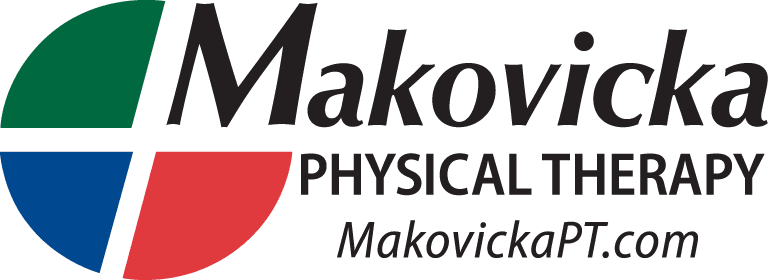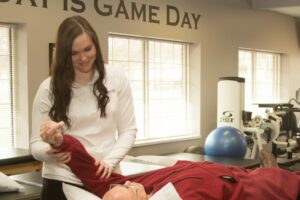Pickleball is a fast-paced, dynamic sport that is growing in popularity every month. While it’s fun to stay active, pickleball’s repetitive motions and quick movements can sometimes lead to shoulder pain, especially for those who play frequently. The team at Makovicka Physical Therapy can help pickleball players manage and overcome shoulder pain, ensuring they can continue enjoying the game they love.
Common Causes of Shoulder Pain in Pickleball Players
Shoulder pain in pickleball players often stems from the repetitive overhead motions and sudden, forceful movements required during play. Some of the most common shoulder issues include:
- Rotator Cuff Tendinopathy (tendinitis): The rotator cuff is a group of muscles and tendons that stabilize the shoulder. Repeated, unaccustomed, overhead motions, like serving or smashing in pickleball, as well as backhand hitting can cause changes in tendon structure, potentially leading to pain and weakness.
- Shoulder Impingement: This occurs when the normal compression of the rotator cuff tendons into the overlying scapula (shoulder blade) is no longer tolerated by the shoulder and becomes painful. There are many debated reasons impingement may become painful including shoulder movement quality and overall muscle and tendon capacity.
- Bursitis: The bursa is a fluid-filled sac that cushions the shoulder joint. Overuse or strain can cause inflammation of the bursa, resulting in pain and restricted movement.
- Labral Tears: The labrum is a ring of cartilage that surrounds the shoulder socket and provides additional shoulder stability. Injuries such as falls or repeated high speed or high load stresses have potential to injury the labrum, leading to pain and instability in the shoulder.
Movement Specialists-How a Physical Therapist Can Help
Physical therapists are experts in movement and function, and they can play a crucial role in diagnosing, treating, and preventing shoulder pain in pickleball players. Here’s how they can help:
1. Accurate Diagnosis
Before any treatment can begin, it’s essential to understand the exact cause of shoulder pain. A physical therapist from Makovicka Physical Therapy will perform a thorough assessment, which may include:
- Strength Testing: Evaluating the strength of the shoulder muscles to identify any imbalances or weaknesses.
- Range of Motion Assessment: This involves checking the shoulder’s flexibility and mobility to pinpoint areas of restriction or pain.
- Movement Analysis: Observing how the shoulder moves during specific pickleball-related actions to identify faulty movement patterns contributing to the pain.
- Specialized testing: Taking the shoulder through specific positions with and without resistance to determine which tissues are likely generating pain.
2. Personalized Treatment Plans
Once the cause of the shoulder pain is identified, the physical therapist will create a personalized treatment plan tailored to the player’s specific needs. This plan may include:
- Strengthening Exercises: Targeted exercises to build strength in the shoulder muscles, particularly the rotator cuff and the muscles around the shoulder blade (scapula). Stronger muscles provide better support for the shoulder joint, reducing the risk of injury.
- Stretching and Flexibility: Gentle stretching exercises to improve the shoulder’s range of motion and reduce tightness in the muscles and tendons.
- Manual Therapy: Hands-on techniques to relieve pain, improve mobility, and enhance muscle function.
- Neuromuscular Re-education: Training using specific movements and techniques to improve muscle control and timing.
3. Education and Prevention Strategies
Preventing shoulder pain is just as important as treating it. Physical therapists educate pickleball players on how to protect their shoulders during play. This includes:
- Warm-Up Routines: Teaching players effective warm-up exercises that prepare the shoulder muscles and joints for the game’s demands.
- Proper Technique: Helping players refine their stroke mechanics and body positioning to reduce unnecessary strain on the shoulder.
- Rest and Recovery: Advising on the importance of rest periods, especially after intense play, and strategies for effective recovery, such as using ice or heat.
4. Return to Play
After completing a course of physical therapy, the goal is to safely return the player to pickleball without pain or limitations. The team at Makovicka Physical Thearpy will guide players through a gradual return to play, ensuring that their shoulder is strong, flexible, and ready for the demands of the game, including:
- Progressive Strengthening: Gradually increasing the intensity of strengthening exercises to match the player’s level of play.
- Sport-Specific Drills: Incorporating pickleball-specific movements into therapy sessions to simulate the demands of the game.
- Ongoing Support: Providing long-term strategies to maintain shoulder health and prevent future injuries.
Expert Care at Makovicka Physical Therapy–Keeping Pickleball Players Active and Injury-Free
Shoulder pain doesn’t have to sideline your pickleball game. Physical therapists are key allies in helping players overcome pain, recover from injuries, and prevent future issues. With the right diagnosis, treatment, and preventative strategies, you can get back ‘in the kitchen’ and on the court!

